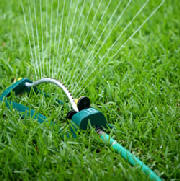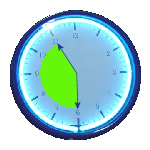
Watering After a Spray Application

The best time to water your lawn after it has been treated is a very good question. Unfortunately, there isn't one simple answer that is right in all situations. As a general rule you should apply around 1/2 inch of water within roughly 24 hours after your lawn has been treated. Read below for a more details on the post treatment watering.
Each of The Other Side Lawn Service's 4 liquid applications contain a different mix of fertilizers and pesticides designed for the specific time of year for which they are being applied. Each of these ingredients has different watering requirements that need to be taken into consideration. Our goal is to establish a watering schedule which represents the best compromise for the various fertilizers and pesticides and provides the maximum benefit to your lawn.
Fertilizers work primarily by improving the fertility of the soil. Turfgrass plants absorb these nutrients through their root systems. Therefore, fertilizers can be watered in immediately following application. Also, because fertilizers can burn turfgrass if left on the leaf surface for too long in hot conditions, maximum benefit is achieved by watering as soon as possible.

Insecticides can work both topically or in the soil profile, depending on the targeted insect species. Therefore, it is best to allow the spray mixture to dry completely on the lawn before watering it in, but not to wait longer than a day before washing it into the subsurface where it can reach soil dwelling insects. In our area insects which feed either at the surface or just below the surface cause the most damage. Thus, it is best to water the insecticides in soon after application.
Herbicides fall into two main categories which have different watering requirements. Pre-emergence herbicides typically target grassy weeds such as Crabgrass and foxtail. This type of herbicide works by attacking the weed in its early stages of development, before it emerges from the soil. Because of this, pre- emergent herbicides need to be watered into the upper soil profile in order to work properly, and should be watered in as soon as possible. Broadleaf herbicides typically work post-emergence, and are targeted at broadleaf weeds such as dandelions. Broadleaf herbicides coat the weed's leaf surface from which they are translocated down into the root system. For best results, watering should be delayed as long as possible, typically 24 hours. However, when weeds are actively growing, excellent control can often be achieved with as little as 2 to 3 hours of contact time prior to watering.
Another important factor that must be considered is the weather conditions. Turfgrass lawns are more susceptible to burning from fertilizers and herbicides during hot, dry periods. For this reason, we use slow release fertilizers for our 2nd and 3rd application. Still, if your lawn is already under stress from high temperatures and dry conditions, it is best to shorten the time until watering to 8 to 12 hours. Conversely, if the weather has been cool and damp, waiting slightly longer than 24 hours should not be harmful.

Despite all the above variables, it is also extremely important to water at the proper time of day, even if it means watering slightly before or after the recommended time. Whenever possible, try to water your lawn between the hours of 6:00AM and 11:00AM. This gives you the best combination of lower tempratures and lighter breezes. You should never water your lawn in the evenings or after dark, especially if your lawn has a history of fungal infections. For more information about lawn irrigation, please see our Watering Tips sheet.
